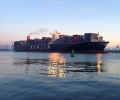In-water or dry dock – when is the best time to polish your propeller?

It’s already well known that regular propeller polishing can help achieve better fuel efficiency and most vessels will have a standard maintenance programme in place to do this – typically six to 12 months. However when the vessel is in dry dock a decision is often made to polish the propeller so what’s the difference? Jean-Paul Engels shares his thoughts…
In-water polishing
A propeller, which is maintained and polished in-water, will be delivered with an average surface finish of 1 micron or better (Rupert Grade A). This very fine finish is possible due to the rotation of the polishing pad creating a centrifugal suction of up to 120kg/cm2, which is holding the polishing pad 100 per cent flush to the propeller blade surface. The water creates the necessary cooling to achieve a surface finish, which is much finer than can be achieved in a dry environment.
Dry dock polishing
A standard polish in dry dock will at best deliver a surface finish of three to four micron (Rupert Grade B). The costs are higher for a dry dock polish – the first thing is getting access to the propeller. Scaffolding has to be arranged so the propeller technician can reach the entire propeller. On average it costs 50 per cent more to polish in dry dock versus in-water. The final quality of the dry dock polishing is highly dependent upon the skill set of the technician executing the work as they do not have the centrifugal suction. The polishing tool is pushed to the blade surface at an angle, which creates the typical ‘banana shaped’ polishing marks on the blade surface after polishing.
Apart from the finer surface finish and lower costs, an underwater propeller polish can add additional benefits if planned correctly. Divers can report on condition of paint, anodes, rope guard and the rudder, which allows the vessel owner to monitor or take action on defects while their vessel is still in service. This early intervention can prevent future costs escalating.
Source: V-Group
HEADLINES
- Do shipping markets want Biden or Trump for the win?
- All 18 crew safe after fire on Japanese-owned tanker off Singapore
- Singapore launching $44m co-investment initiative for maritime tech start-ups
- Cosco debuts Global Shipping Industry Chain Cooperation Initiative
- US warns of more shipping sanctions
- China continues seaport consolidation as Dalian offer goes unconditional